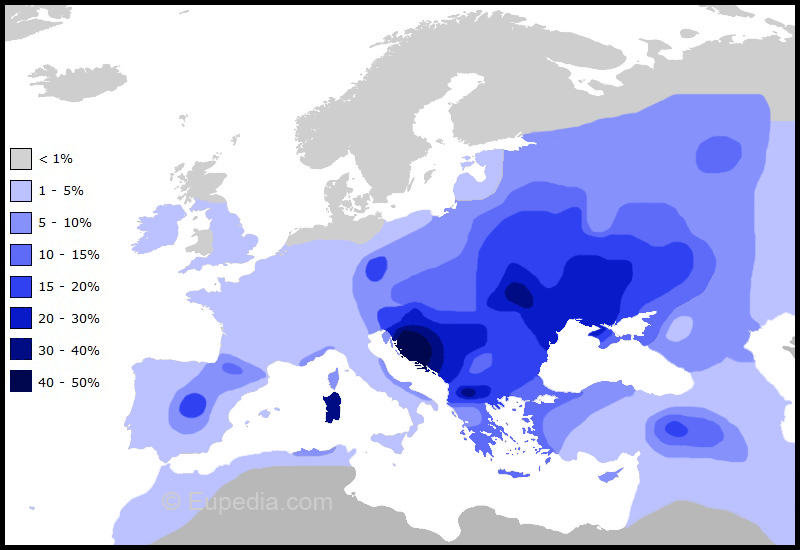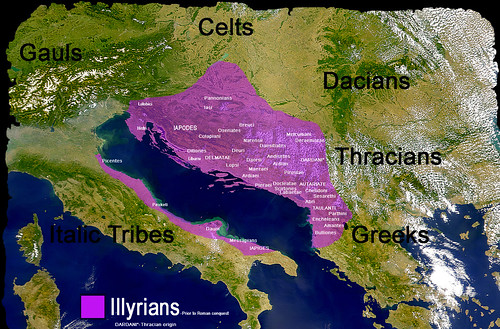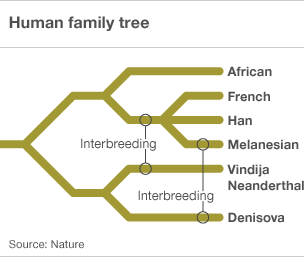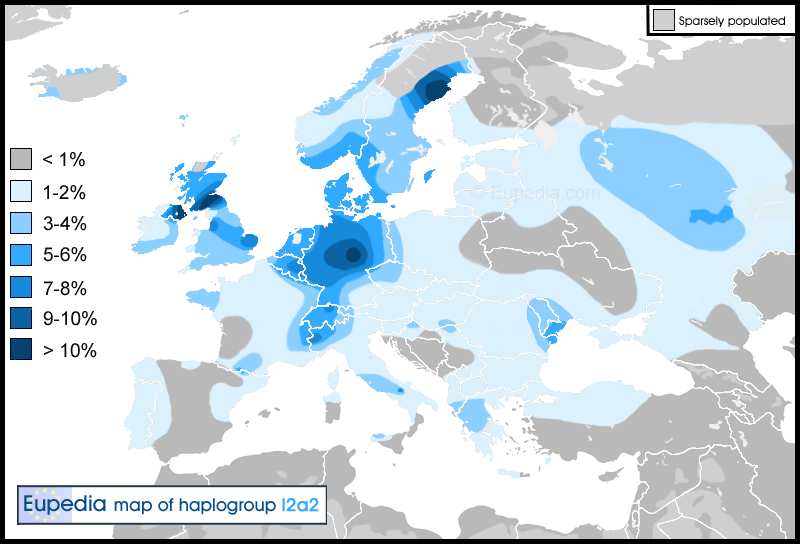Sujet : Haplogroup I, premier arrivé en Europe | |  Posté le 05-03-2011 à 17:59:33 Posté le 05-03-2011 à 17:59:33
| L'Haplogroupe I
détaché du macro haplogroup IJ il y a environ 22 000 ans
IJ puis I sont l'haplogroupe des premiers hommes modernes entrés en europe au Paléolithique

L'Europe au dernier age glaciaire (solutréen et proto solutréen en marron, Epi Gravettien en violet)

haplogroup I1

expansion de tribus germaniques

Haplogroup I2:

Culture de Cucuteni Triploje

Illyriens
 |
| |  Posté le 08-03-2011 à 12:42:21 Posté le 08-03-2011 à 12:42:21
| Je me trompe peut-etre, mais la carte des I2 semble etre la carte des I2a, n'intégrant pas les I2b du sud de la Baltique qui ont leur maximum en Basse-Saxe.
Quant à la date d'arrivée du Groupe I en Europe Cela peut etre le proto-aurignacien (35000 non calibré et/ou le gravettien (29000 non cal) et/ou les solutréen/epigravettien (22000 non cal). et/ou le gravettien (29000 non cal) et/ou les solutréen/epigravettien (22000 non cal).
Edité le 08-03-2011 à 12:46:55 par thersite
|
| |  Posté le 08-03-2011 à 12:53:15 Posté le 08-03-2011 à 12:53:15
| je dirai que pour I c'est exact par contre faire provenir R de l'Inde est une erreur.
Pour I il ya les I2a et I2b bien que je ne m'y retrouve plus depuis qu'ils ont changé les classements, mais pour résumé disont les iberian et dinaric et britton avec I2a et les scandinavic avec I1.
Effectivement Thersite la carte est I2 est en fait I2a1b et I2a2b. |
| |  Posté le 08-03-2011 à 21:15:10 Posté le 08-03-2011 à 21:15:10
| thersite a écrit :
Quant à la date d'arrivée du Groupe I en Europe Cela peut etre le proto-aurignacien (35000 non calibré et/ou le gravettien (29000 non cal) et/ou les solutréen/epigravettien (22000 non cal). et/ou le gravettien (29000 non cal) et/ou les solutréen/epigravettien (22000 non cal). |
Je pense que c'et IJ qui est arrivé en Europe et que l'haplogroupe I s'est ensuite sparé il y a 20000 ans.
Ce serait intéressant de trouver des individus IJ, sachant qu'on a trouvé des individus DE en Afrique |
| |  Posté le 08-03-2011 à 22:09:46 Posté le 08-03-2011 à 22:09:46
| | normalement IJ n'existe pas car I (M170) et J sont chacun une mutation de C (M89) ou H et il n'est pas certain que le groupe IJ n'est jamais existé ou plus brièvement c'est probable. I et J sont vieux au plus de 30/40 000 ans en arrière lorsqu'ils arrivent en Europe selon les estimations de durées par génération, et ensuit séparé entre I1 et I2 environ 15/20 000 ans en arrière vers la même époque en fait que R1a1 et R1b (R1a2) et donc on peu supposé que c'est liè au début de la find de la glaciation quand commencent à fondre les glaciers en Europe et ailleurs! Cela correspond aussi au déclin des populations néandertaliennes. |
| |  Posté le 19-03-2011 à 12:12:52 Posté le 19-03-2011 à 12:12:52
| | dire qu'ils étaient les premiers arrivés c'est ne pas tenir commpte de néandertal et nous sommes en Erope pour 10% néandertal en moyenne. |
| |  Posté le 19-03-2011 à 12:28:13 Posté le 19-03-2011 à 12:28:13
| | Ce chiffre vient de quelle source ? |
| |  Posté le 19-03-2011 à 16:44:57 Posté le 19-03-2011 à 16:44:57
| | des dernières données après qu'ils aient effectué la totalité du génome de néandertal, et sauf les subssharien nous avons tous du néandertal et pour les européens nous sommes aux alentours de 10%. |
| |  Posté le 19-03-2011 à 16:46:12 Posté le 19-03-2011 à 16:46:12
| | et ce serait surtout sur l'adn mitochondrial. |
| |  Posté le 19-03-2011 à 22:14:30 Posté le 19-03-2011 à 22:14:30
| martiko a écrit :
et ce serait surtout sur l'adn mitochondrial. |
Et quel haplogroupe en particulier ? U5? |
| |  Posté le 20-03-2011 à 10:54:29 Posté le 20-03-2011 à 10:54:29
| "et sauf les subssharien nous avons tous du néandertal "
>>>>>>>C'est à dire que les asiatiques, australiens et amérindiens ont aussi un peu de Néanderthal ? Et que seuls les Africains du sud n'en ont pas ? |
| |  Posté le 20-03-2011 à 23:23:46 Posté le 20-03-2011 à 23:23:46
| | oui exact ! mais plus chez les européens et les asiatiques. |
| |  Posté le 21-03-2011 à 02:21:02 Posté le 21-03-2011 à 02:21:02
| Atil a écrit :
"et sauf les subssharien nous avons tous du néandertal "
>>>>>>>C'est à dire que les asiatiques, australiens et amérindiens ont aussi un peu de Néanderthal ? Et que seuls les Africains du sud n'en ont pas ? |
En tout as les mélanésiens semblent avoir en partie hérité de l'homme de Denisova, proche cousin de Néanderthal
In March 2010, discovery was announced of a finger bone fragment of a juvenile that lived about 41,000 years ago found in Denisova Cave (Altai Krai, Russia), a region also inhabited at about the same time by Neanderthals and modern humans.[1][2] The mtDNA of the Denisova hominin is distinct from the mtDNAs of Neanderthals and modern humans.[3] In December 2010, an international team of scientists determined the sequence from the nuclear genome of this group (known as the Denisovans) from this finger bone. According to their analysis, this group shares a common origin with the Neanderthals and interbred with the ancestors of modern Melanesians.[4] |
| |  Posté le 21-03-2011 à 09:26:04 Posté le 21-03-2011 à 09:26:04
| | Serait-il possible que les différences entre ls actuelles "races" humaines soient dues à des métissages avec des pré-sapins différents ? |
| |  Posté le 21-03-2011 à 12:11:18 Posté le 21-03-2011 à 12:11:18
| Atil a écrit :
Serait-il possible que les différences entre ls actuelles "races" humaines soient dues à des métissages avec des pré-sapins différents ? |
C'est là la limite des Haplogroupes Y et Mtdna pour expliquer le phénotype ds humains. les différences au sein du maro haplogroupe MNOPS sont si énormes (présence ou pas de traits mongoloides) qu'elles semblent rendrent compte de métissage avec d'autres hominidés.
Je cite ici des extraits du site eurpedia (encore) sur les traits physiques des asiatiques et européens:
Some French and American researchers also found convincing evidence of an direct evolution from the Asian Homo Erectus toward the modern Asian Homo Sapiens, probably after interbreeding with a new arrival of Homo Sapiens from the Middle East.
C is one of the oldest haplogroups in the world, and the oldest outside Africa. It correspond to the first migration to Asia (along the Indian Ocean coast) 70,000 years ago. It is found everywhere from Australia to Siberia and North America. I imagine that C people must have mixed with the descendants of the Homo Erectus (Peking man) in East Asia to become the first Mongoloid people. The higher percentage of C in Mongolia also correlates with stronger Mongoloid traits.

O and R people stem from a relatively recent (35,000 years) ancestor in Central Asia. The best explanation for the rift between Caucasian and Mongoloid population around central Asia is that the original O and R people mixed with older populations that already had clearly distinct Caucasian and Mongoloid traits. It is certain from archaeological evidence that the first East Asian Homo Sapiens 60,000 years ago already had Mongoloid traits, and the first Europeans (Cro-Magnons, 45,000 years ago) had Caucasians traits. O and R may represent some 70 to 90% of the lineages today, but their autosomal impact was much less, because their genes were diluted by those of indigenous women.
In Siberia, N and Q might very well have replaced older C lineages, which would explain why N and Q people have Mongoloid traits, like O people, but unlike R people. Haplogroups N, O, P, Q and R all originated from a common ancestor. N, O, P and Q are almost always found side by side to a minority of C and D lineages. R is usually found among E, F, G, H, I and J populations. N, O, P and Q almost always have Mongoloid mtDNA (A, B, C, D, F, G, M7, M8, N9, Y, Z), except in/around Finland, while R1 men typically have Caucasian mtDNA (H, I, J, K, T, U, V, W, X).
The difficulty is to determine whether the original NOPQR population was a unique racial group different from the Mongoloids and Caucasians, and whether they carried unique mtDNA lineages too. I wouldn't be surprised if mtDNA X had a connection with the original NOPQR people, as it is found in all Eurasia, indistinctively among Caucasians and Mongoloids. It is also found among Native North Americans (Y-DNA Q). Its age (30-35,000 years) corresponds to the timeframe of the split between NOP, Q and R. |
| |  Posté le 21-03-2011 à 12:19:42 Posté le 21-03-2011 à 12:19:42
| Les caractéristiques caucasoides des européens proviennent peut être de l'homme de Néanderthal si l'on compare les traits physiques respectifs de chacun:
[i][i]The first full Neanderthal genome is not yet complete, and only a few hundreds modern people have had their whole genome tested. Unfortunately, even with one or several complete Neanderthal genomes available for comparison, there is no way of knowing what we inherited from them. We need to know what the genes of Middle Paleolithic Homo Sapiens (prior to the encounter with Neanderthal in Europe) looked like.
It is almost certain now that the first Homo Sapiens to penetrate in Europe had black skin, hair and eyes. So they were obviously genetically different from modern Europeans. Being hunter-gatherers they also lacked many mutations found in modern Europeans that allow to digest lactose, cope with the high-sugar diet of agricultural societies, and a long series of immune system adaptations to better resist new diseases that arose from life after domestication or in crowded cities.
scientists have found numerous evidences that our Homo Sapiens ancestors from Africa intermingled to some extent with the indigenous Neanderthal of Europe and the Middle East. The strongest evidence of interbreeding were found in Eastern Europe, where the blond-haired and blue-eyed "Aryans" (Celts, Germans, Slavs...) originated before taking over the rest of Europe after the end of the Ice Age. It is thus possible that modern Europeans (and people of European descent) still have a tiny percentage of Neanderthal DNA, and thus also some physical characteristics of Neanderthal usually not found in other humans on the planet.
Wikipedia lists here the Neanderthal physical traits. As they are written in technical terms, let me rephrase below the ones that can easly be found by self-inspection. Please do not compare with your relatives as they are genetically similar to you.
- Occipital bun : a protuberance of the occipital bone (back of the head) that looks like a hair knot. You have it if you can feel a rounded bone just above the back of your neck (same height as the ears).
- Low, flat, elongated skull : What matters here is especially the "elongated skull", as opposed to the back of the skull being almost vertical, like East Asian people.
- Retromolar space posterior to the third molar : i.e. an empty space behind the "wisdom teeth".
- Supraorbital torus : protruding eyebrow bone (including big deep eye cavity between the eye and eyebrow).
- Bigger, rounder eyes than average.
- Broad, projecting nose : angle of the nose bone going more upward than average (not falling straight like a "Greek nose").
- Bony projections on the sides of the nasal opening : i.e. nose bone making a "triangle" between the nose and cheeks/orbits.
- Little or no protruding chin
- Larger mental foramen in mandible for facial blood supply : this means that the side jaw and cheek are bigger or better supplied in blood than average. This increased blood supply could result in the cheeks being red (like blushing) when doing physical exercise or when the weather is cold.
- Short, bowed shoulder blades : i.e. shoulder bones curving toward the front more than average.
- Large round finger tips : typically "flat" and wide finger tips, especially the thumb (e.g. if your thumb is more than 1.5 cm wide).
- Rufosity : i.e. having red hair, or brown hair with red pigments, or natural freckles.
- Fair skin, hair and eyes : Neanderthals are believed to have had blue or green eyes, as well as fair skin and light hair. Having spent 5x longer in northern latitudes than Homo Sapiens, it is only natural that Neanderthals should have developed these adaptive traits first, and that the first modern humans that arrived in Europe inherited the whole package through interbreeding.
[/i][/i] |
| |  Posté le 27-07-2011 à 18:47:53 Posté le 27-07-2011 à 18:47:53
| 
Je me demande à quoi correspond I2b dans le sud-est de la France |
| |  Posté le 27-07-2011 à 22:06:50 Posté le 27-07-2011 à 22:06:50
| Quelle source et quelles marqueurs ?
Peut-etre à une arrivée de populations de culture cardiale et aussi plus tard venant des Balkans
Maximum I2-M423 dit dinarique sur cote dalmate et Herzégovine. Plus de la moitié
de la population des Croates et Bosniaques.
Maintenant appelé I2a1b1a-Dinaric : marqueurs P37.2, L178,M423,S163/L69, L147 |
| |  Posté le 29-07-2011 à 11:58:16 Posté le 29-07-2011 à 11:58:16
| Je me referais à l'ancienne nomenclature I2b, ce sous groupe de I2 connait son maximum vers les montagnes du Harz en Allemagne ainsi que dans le Nord Est de la Suède.
Sa répartition signale souvent une invasion germanique (est de l'Angleterre, Benelux...) mais dans le sud -Est de la France, à part les Bourguignons je vois pas trop... |
| |  Posté le 29-07-2011 à 17:44:48 Posté le 29-07-2011 à 17:44:48
| C'est vrai, M423 était I2a2 et non I2b avant la récente recodification.
D'après récente d'universitaires espagnols avec l'Institut du sang,
PACA sur 45 testés I(xI2a2)=6,67% , I2a2-M423=2,22%
mais le nombre de testés est faible.
Une étude a l'institut médico-légal de Lyon n=125 I=10,2%
Avez-vous d'autres sources ? |
| |  Posté le 29-07-2011 à 19:36:22 Posté le 29-07-2011 à 19:36:22
| | "détaché du macro haplogroup IJ il y a environ 22 000 ans " je constate la division par 2 qui ramène la naissance et la séparation du goupe I auparavant estimé à 40/45 000 ans |
|
|
|